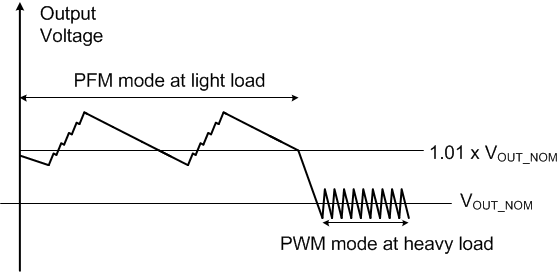SNVSC74B September 2023 – December 2024 LP5813
PRODUCTION DATA
- 1
- 1 Features
- 2 Applications
- 3 Description
- 4 Device Comparison
- 5 Pin Configuration and Functions
- 6 Specifications
-
7 Detailed Description
- 7.1 Overview
- 7.2 Functional Block Diagram
- 7.3 Feature Description
- 7.4 Device Functional Modes
- 7.5 Programming
- 8 Register Map Table
- 9 Application and Implementation
- 10Device and Documentation Support
- 11Revision History
- 12Mechanical, Packaging, and Orderable Information
Package Options
Mechanical Data (Package|Pins)
- YBH|12
- DRR|12
Thermal pad, mechanical data (Package|Pins)
- DRR|12
Orderable Information
7.3.1.6 Boost PFM Mode
The LP5813 works at PFM to improve efficiency at light load. When the load current decreases, the inductor valley current set by the output of the error amplifier no longer regulates the output voltage. When the inductor valley current hits the low limit, the output voltage exceeds the setting voltage as the load current decreases further. When the feedback voltage hits the PFM reference voltage (0.6V typical), the LP5813 works at PFM. When the feedback voltage rises and hits the PFM reference voltage, the device continues switching for several cycles because of the delay time of the internal comparator — then it stops switching. The load is supplied by the output capacitor, and the output voltage declines. When the feedback voltage falls below the PFM reference voltage, after the delay time of the comparator, the device starts switching again to ramp up the output voltage. Figure 7-2 showes the waveform of voltage when the device works at PWM and PFM.
 Figure 7-2 Output
Voltage in PWM Mode and PFM
Figure 7-2 Output
Voltage in PWM Mode and PFM